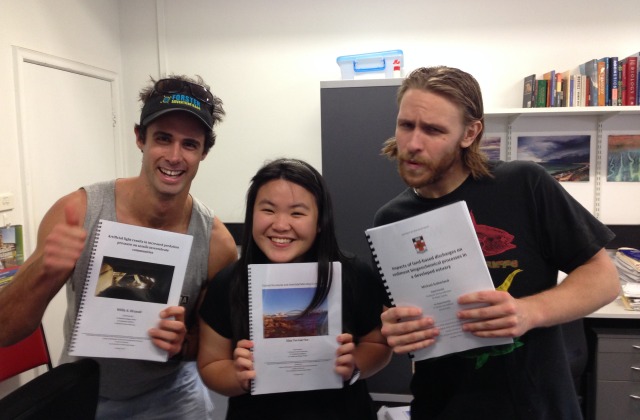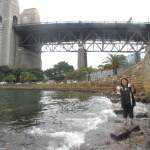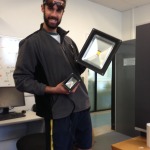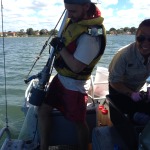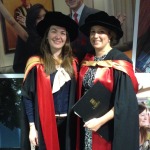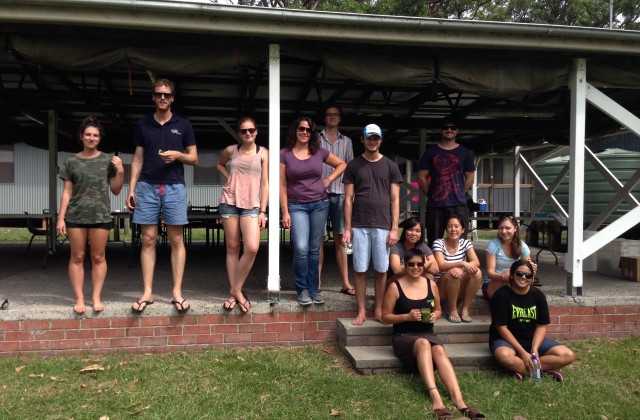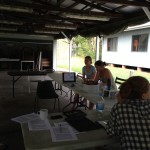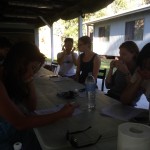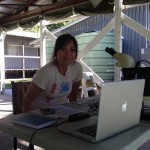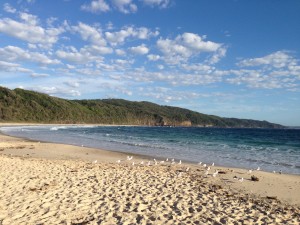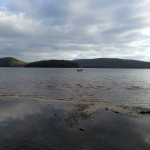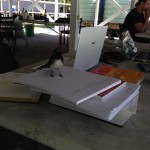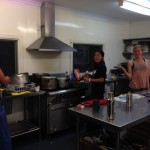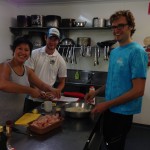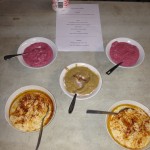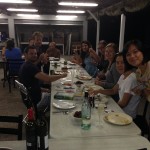Congratulations AMEE lab Honours Students!
As of 12 noon today, our honours students will be released from their desk shackles and allowed back into the sunlight after 10 months hard work in the field and lab to produce excellent theses on a variety of topics. A wonderful achievement by all.
Elisa Tan – Coastal structures and intertidal microbial communities.
Abstract
Coastal landscapes are heavily modified due to the increasing need for artificial structures and the protection of existing infrastructure. Artificial structures are often built at the expense of natural habitats, and may become the dominant intertidal habitat without a comprehensive understanding of their ecological consequences. Artificial structures support different macrofaunal communities to natural rocky shores; however, little is known about the microbial communities present on such structures. Microbes are important as they form the basis of ecological processes such as nutrient cycling and primary production in intertidal systems. Studying microbial communities will allow a more comprehensive understanding of the biodiversity and ecosystem functioning of artificial structures in marine environments. In this study, the bacterial communities of intertidal biofilms were compared between artificial structures (seawalls) and natural habitats (rocky shores) within Sydney Harbour. Biofilms were assessed using Automated Ribosomal Intergenic Spacer Analysis (ARISA) and Illumina Miseq sequencing platform. A total of 573 Operational Taxonomic Units (OTUs) were identified from ARISA while 486 unique sequences were identified via Miseq. Intertidal bacterial communities on seawalls were more variable than communities on natural rocky shores. Although there were some observed differences in the structure of intertidal bacterial communities between natural and artificial habitats, these differences were not reflected on the physiological state of biofilms, as measured in situ using a diving Pulse Amplitude Modulated (PAM) fluorometer. The potential ecological consequences of the observed differences in bacterial communities between habitats should be a research priority given the existing prevalence, and rapidly increasing number of coastal artificial structures.
Wills Brassil – Artificial light results in increased predation pressure on sessile invertebrate communities.
Abstract
Urban centres are often located near the coast to ensure the efficiency of transportation and trade. However, it is only recent developments in artificial lighting technologies that have allowed artificial light pollution to extend far beyond the boundaries of these cities. Natural cycles of light and dark play a vital role in many aspects of ecology in coastal marine ecosystems including complex predator-prey interactions. Very little is known about the effects of artificial light on predation in marine systems, yet the reach of artificial light in this environment is increasing rapidly. This study investigated whether artificial light influenced predation on sessile invertebrate communities in an urbanised coastal environment. To do this, naturally formed sessile invertebrate assemblages were exposed to predation during the day, the night or the night with artificial lighting. Change in the percentage cover of invertebrate functional groups was recorded. Total reductions in cover of all invertebrates were lowest in assemblages exposed to predators during the night. The addition of artificial lighting increased invertebrate cover loss equivalent to half of the losses observed during the day. Different functional groups were targeted during the day, the night or the night with artificial lights. This is one of the first studies to show that artificial lights influence the ecology of estuarine assemblages through changes to the overall predation level and effects on community structure. Artificial lighting should become an increasing focus of ecological studies in urban coastal environments and the results could inform the design of coastal infrastructure and the management of coastal activities.
Michael Sutherland – Impacts of land-based discharges on sediment biogeochemical processes in a developed estuary.
Human development of the coastal environment is by far the greatest threat to the sustained health of many estuaries. Human activities both along shorelines and within catchments modify physical, chemical, and biological components of these fragile ecosystems, potentially interfering with important ecological functions. The introduction of foreign contaminants, primarily macronutrients carbon, nitrogen, and phosphorus, is commonly associated with the urbanisation of estuarine basins. Materials containing these nutrients are introduced into estuaries via natural and artificial waterways, and settle into soft-sediment assemblages, where they can potentially interfere with benthic biogeochemical processes i.e. organic matter decomposition, primary production, and the cycling of nutrients. This field-based study measured benthic responses to in situ exposures to anthropogenic stormwater discharges, and compared those responses between locations with differing retention conditions for stormwater. Significant modifications to benthic metabolism were observed both in responses to distance from discharge sources, as well as between locations with varying retention conditions. Increased benthic O2 consumption was evident closest to stormwater sources, and these changes were found to affect benthic productivity, primarily through modifications to the cycling of nitrogen within the system. Consistent differences were observed on four sampling occasions; each considered to represent baseline anthropogenic flows. Our study revealed substantial changes to ecosystem function close to stormwater drains and indicates the potential for more substantial threats to ecosystem functioning following significant rainfall.
Happy graduation Dr Katelyn Edge!
Today I joined the academic procession on stage in the UNSW Clancy Auditorium to celebrate the PhD graduation of Dr Katelyn Edge. Fun and photos in our academic gowns!
AMEE Lab Writing Retreat 2014
Smiths Lake Field Station 24-28 February 2014
It was an early start and a few hundred kms on the freeway north before the Subtidal Ecology and Ecotoxicology lab was finally assembled at the university field station on the shores of Smiths Lake.
After exploring the accommodation and surrounds we got straight into all things writing with our first grammar activity on ‘The Removeable Clause’ led by Simone.
We alternated grammar activities with paper reviews from members of the lab beginning with Melanie‘s research on microbial community networks and anthropogenic stress in estuaries.
Most days were spent hard at work writing and researching and Vivian found some time to work through microplastic samples collected from a large survey of Sydney Harbour sediments.
We also found some time to enjoy the beautiful natural surroundings…
…and even rescue each other from the lake during boat safety drills with Penny.

And when we couldn’t leave our computers, nature came to us.
Our bird friends, Willy and Wally, were the most frequent visitors.
As darkness fell, the competition got hot with controversial card games….
… and a cooking contest! Mariana‘s team kicked things off with Brazilian and Indian fusion. Beginning with sizzling empanadas and followed by Sally‘s curry creations.
Team awesome (Aria, James and Kingsley) followed with a Moroccan inspired menu of homemade dips and sizzling BBQ meat.
The advantage to a superb feast being…..
very little left to wash up!
Stay tuned for new publications from the retreat!
